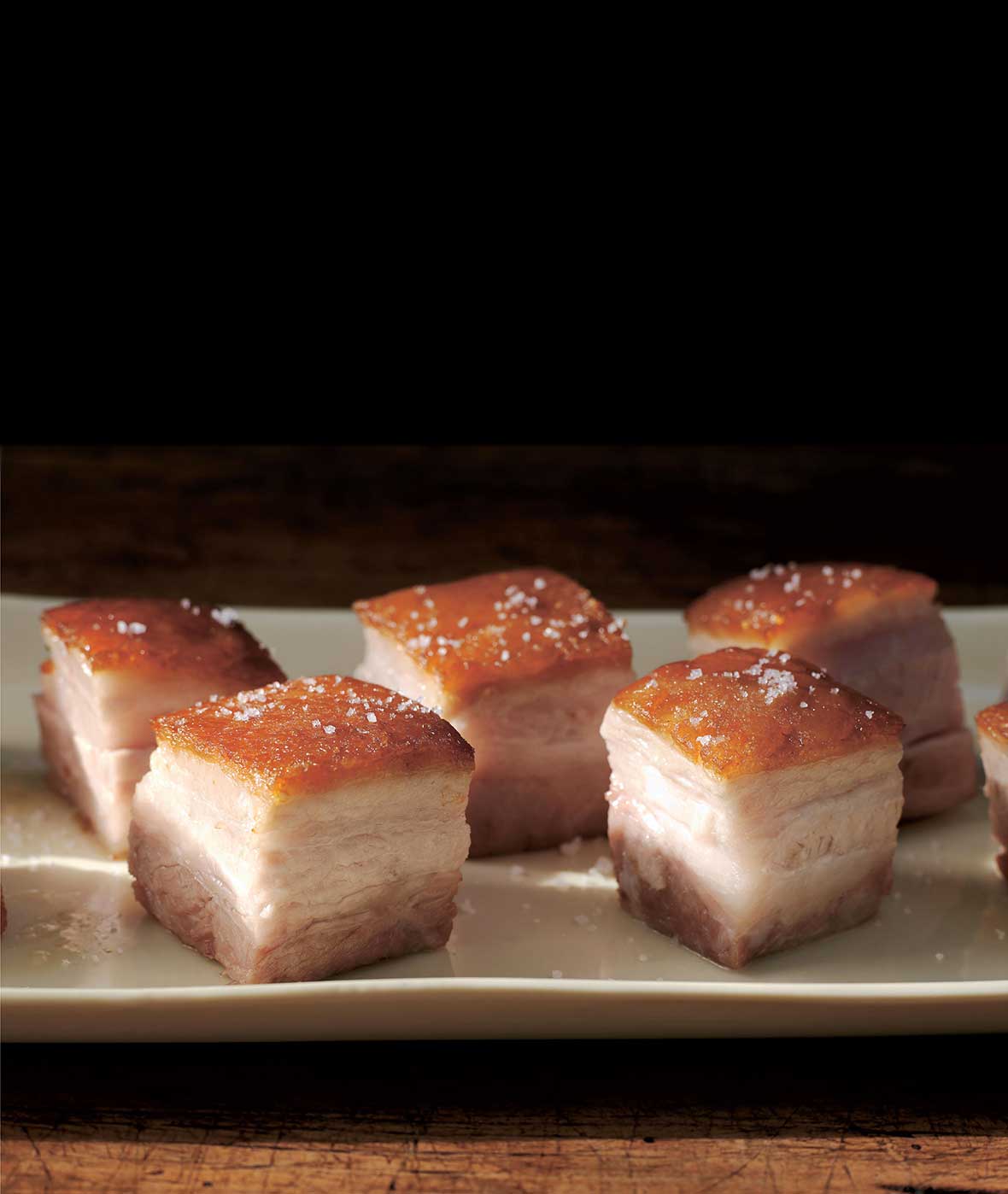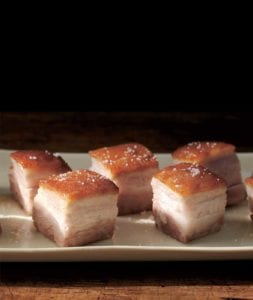
All hail, pork belly, nature’s striated masterpiece of fat and lean, the succulent essence of pig.
On the plate, pork belly appears in countless guises. The lattice paving atop a Cantonese dish of braised bitter greens. The hickory-burnished slabs wheeled out of a Kentucky smokehouse. The crisp nuggets strewn over a frisée salad. Swirled into the folds of Shanghai fried noodles. The fork-soft slabs you fished out of your last choucroute. In Los Angeles, some Korean restaurants serve practically nothing but the belly sliced thin, grilled atop charcoal braziers set into the tables, and served with a swipe of sesame oil and a sprinkle of salt. When I organized a food event last spring with 40 of my favorite chefs cooking to support an environmental organization, nearly half of them served pork belly of one kind or another, and Octavio Becerra’s pork-belly banh mi was one of the best things I’ve ever tasted. Commodity-exchange comedians don’t make jokes about pork belly futures any more.
Pork belly contains within itself both the potential for juice-spurting transgression and the wholesomeness of Sunday-morning breakfast, the more lewd pleasures of screaming excess and the quiet satisfaction that comes with making something delicious out of something inexpensive (or what was once inexpensive and is now merely affordable). Last year after I ordered half a plum-fed pork belly from Heritage Foods USA, I stayed up through the night pondering what I might do with the splendid piece of meat—smoke it or braise it, dry-rub it with fennel pollen and rosemary or cumin and mortar-ground chile pequin, invite the neighbors or hoard it for my family. I ended up slow-roasting it and serving it with a Santa Rosa plum compote to friends.
Now that pork belly has passed its peak of media saturation and fashionable chefs have moved on to ears, feet, and eyeballs, it may be time for the rest of us to explore its more subtle but no less luxurious qualities, its tendency to forgive even the longest braises, its crackling surface that melts away to almost nothing, something even the most trepidatious home cook can tease out. Let us celebrate the belly’s divinely piggy meatiness. Its utter adaptability to flavors Thai or French, Japanese or Czech. Its three-star kitchen results without the three-star kitchen.

Pork Belly Confit
Equipment
- Deep-fry or candy thermometer
Ingredients
For the brine
- 1/4 cup plus 2 tablespoons honey
- 12 bay leaves
- 3 large rosemary sprigs
- 1/2 bunch thyme
- 1/2 bunch flat-leaf parsley
- 1/2 cup garlic cloves, crushed, papery skin left on
- 2 tablespoons black peppercorns
- 1 cup kosher salt
- 8 cups water
For the confit
- 1 batch pork brine
- One slab pork belly
- About 6 cups lard, at room temperature
For the assembly
- Canola oil
- Coarse sea salt
Instructions
Make the brine
- Combine all of the ingredients in a large pot, cover, and bring to a boil. Heat for 1 minute, stirring to dissolve the salt, then remove from the heat and let cool completely. Cover and refrigerate for at least 8 hours and up to 3 days.
- Pour the brine into a container large enough to hold the pork. Add the pork, cover, and refrigerate for 10 hours (but no longer as the pork may become salty).
Make the confit
- Remove the pork from the brine, discarding the liquid. Rinse the pork under cold water and pat it dry with paper towels or let it air dry.
- Preheat the oven to 200°F (93°C). Reach for an ovenproof pot that’s only slightly larger than the porkand has a lid, such as a 12-quart Dutch oven. Place the pork in the pot and add enough lard to cover it by 1/2 to 3/4 inch. Attach a thermometer to the side of the pot.
- Place the pot over low heat until the lard registers 190°F (87°C). This could take as long as an hour. Cover the pot, transfer it to the oven, and heat until the pork is meltingly tender. This will probably take 5 1/2 to 6 hours, but start checking after 4 hours.
- Remove the pot from the oven and let the pork cool to room temperature. The pork can be refrigerated as-is, enveloped by lard in the pot, for up to 1 week. (We prefer to first gently press the confit to compress the internal layers and force out some of the excess fat. This results in a better texture and appearance. To press the confit, transfer it to a baking dish and pour just enough lard into the dish to barely cover it. Cover the belly loosely with plastic wrap, place a smaller baking dish on top of it and weight it with a brick, a large can, a cast-iron skillet, or something of similar weight. Refrigerate for at least 12 hours. Cover and refrigerate the reserved lard. After it’s been pressed, the pork can be covered with some of the reserved lard and refrigerated for up to 1 week.)
Serve the confit
- Remove the pot from the refrigerator and let it sit in a warm spot for 1 to 3 hours. You want the lard to soften enough so you can scrape it from the pork, yet you want the pork to remain as cold as possible so it will be relatively easy to slice.
- Remove the pork from the pot and wipe off any lard that clings to the meat. (The lard can be reused to confit additional pork as long as it doesn’t taste too salty. To reserve the lard, pour it into a pot and heat gently to liquefy, then strain through a fine-mesh conical strainer into a storage container. Refrigerate for up to 2 months or freeze for up to 6 months.)
- Using a sharp knife, remove the skin from the pork. Score the fat on the pork belly in a crosshatch pattern. Slice the pork or cut it into squares (actually, the belly can be cut into any shape) and let it rest at room temperature for 20 to 30 minutes.
- Preheat the oven to 350°F (175°C).
- Heat some canola oil in a large ovenproof skillet over medium heat. Carefully place the pieces of confited pork, fat-side-down, in the skillet, being careful not to crowd the pan and also being careful of spatters. (You may need to work in batches.) Immediately reduce the heat to medium-low and cook until the excess fat is rendered and the fatty side is browned, 8 to 18 minutes, depending on the exact temperature of your oil. You may need to pour off any excess fat about halfway through cooking. When the pork is browned, transfer the skillet to the oven until the belly is heated through, about 10 minutes. Remove from the oven, sprinkle with the salt, and serve.
Notes
What Exactly Is Pork Belly?
Pork belly is a boneless cut of fatty meat from the belly of a pig and is considered a delicacy in many cultures. In America, bacon and salt pork (which is used often in soups, stews, and chowders) are the most common ingredients made from pork belly. In Italy, it’s made into pancetta. In Alsace, it’s part of choucroute garnie, and in many Latin countries it’s deep-fried and served as chicharrón–called torresmos in Portugal.
Nutrition
Nutrition information is automatically calculated, so should only be used as an approximation.
Recipe Testers’ Reviews
This pork belly confit is definitely time-consuming but has got to be one of the most addicting foods I’ve made in a long time! The meat comes out so flavorful and tender. The crisp tops almost melt in your mouth, as does the unctuous meat and fat. The wonderful flavor and texture at room temperature kind of reminded me a bit of lardo (different method and not quite as firm, though). That said, I felt the aromatics were somewhat muted. I served this confit plain, as part of a “pork and beans” lunch, where the “beans” were part of a black bean and fava bean salad with grilled corn, grilled pineapple, and a wonderful sweet and savory balsamic dressing.
On and off over the course of a couple of days, this takes about 1 hour or so of one’s attention per day, but not all at once. There are a lot of steps that need to be performed and not all require constant attention. I started this on Wednesday and it was oven-ready by Friday. We cooked and served it Sunday. If folks are going to make this, they should start a couple of days ahead of when they want to serve it. This timing does not include waiting for a week so it can age.
I checked the pot at 5 hours and the pork was delightful but I felt another hour couldn’t hurt—and it didn’t. So the cooking time here is 6 hours, plus the time it takes to remove the pot, test the pork, and return it to the oven.
I did not need to work in batches with my 12-inch cast iron pan. HOWEVER! The fat in the pan started spitting and popping as soon as I put the pork in. Even though it is now confit, there is still moisture there. It works the same with duck and rabbit. One must be careful with this part. Also, the confit is pretty much fall-apart tender at this stage.
I left it in the oven for 10 minutes to warm completely but it was pretty much there after being on the stove. It could have been served right away, actually, or left in the oven a little longer to get a bit hotter. It is excellent almost any way you wish to serve it.
A 10 is warranted for this recipe’s quality, flavor, and attractiveness. If one really wishes to pursue the final product, it’s a considerable amount of work. I had to try this, and feel that this recipe is geared towards an experienced cook. It does yield buttery smooth and flavorful pork confit with a delightfully crisp top for those who understand what is supposed to happen and how to get there. The flavor was exquisite but I wouldn’t expect to, nor did I really notice the presence of the aromatics that much.
Brining is easy but perhaps a bit misunderstood. When putting anything into a brine, be prepared to taste a final product that is pretty much the meat and salt, and if you’re lucky, a modicum of herb or spice. The honey is similar to sugar, in that it helps to provide a beautiful browning colour to the fried part of the confit.
Therefore, I think it might be better to treat this pork belly confit as I would duck confit. With duck confit (and also the rabbit confit), the salt and seasonings are put together beforehand, spread over the meat, and it is allowed to sit overnight. The next day, it gets cleaned off and the meat is added to, and slowly cooked in the lard. It can then be treated the way this recipe does to finish it.
To speed the brine up at the start, you can use half the water (4 cups) to heat dissolve the ingredients. Once the salt is dissolved, then add ice equal to the weight of the second half (32 ounces) and stir to cool things down rapidly.
It is not mentioned but the lidded pot should be large enough to hold the pork belly in a single layer with not much of a gap. This will reduce the amount of lard required to fill in those gaps.










Thank you, Seok. I have rendered lard before, but I wasn’t very happy with it. I think I cooked it too long. You encourage me to try again.
Hi Karen,
I do it in the wok, works like a dream. Just need to do it on a low flame, once the pork fat starts to render you really do not need much heat, but just lots of patience. Another tip is to take out the fat which has turn crispy and golden brown so that it won’t burn and spoil the lard. Hope that helps. Actually fresh lard is very flavourful; you can use some to fry Chinese style noodles or rice. Here is a very popular recipe in Singapore and Malaysia.
Char Kway Teow
1/2 pound Flat rice noodle
1 teaspoon chopped garlic
3 tablespoons lard
3 -to 5 prawns
3 to 5 thinly sliced Chinese sausage
A handful of beansprouts
3 sprigs of chives, cut into 2 inch lengths
1 egg
Seasoning:
1 tbsp chilli paste (blend dried chilli with fresh, ratio 10 dry to 3 fresh)
1 tbsp light soya sauce
Pepper to taste
A little dark soya sauce for colour
A little water
Method
1. Heat wok with 3 tbsp oil until hot and fry Chinese sausages until fragrant, then add l tsp chopped garlic . Add about prawns and fry until cooked.
2. Push all the fried ingredients to one side and add in rice noodles. Stir-fry the noodles and add seasoning and sprinkle with a little water to mix.
3. Spread all the ingredients around the wok and create an empty space in the centre, then crack an egg into it and add a little more oil. Cover the egg with all the ingredients and stir-fry evenly. Mix in a handful of beansprouts and the chives. Do not overcook.
4. Remove the dish to a plate and serve hot.
Up here in Rochester, Wegmans still doesn’t carry pork belly; I’ll find it from a local farmer. BUT how does one acquire 3 lbs of rendered lard? (I’d like to avoid doing it myself, if possible.) I’d like a good lard source for other cooking as well.
Your local farmer should have lard, if he sells pork belly. If not, check with your local farmers markets or the agriculture department of local universities. They may know.
Thanks, David. Yes, I can find plenty of lard, but I haven’t found anyone here who renders it. I keep hoping I can find an online source. Will keep looking.
Hi, Karen. Try Jeffery’s Meat Market. I don’t know if they ship. When I was there (and was making the confit of pork belly), Jeffery was able to get me the lard.
Hi, actually it is easy to render lard. All you have to do is to rinse the pork fat, pat dry then cut into cubes, in a pan best to use cast iron start frying it. The oil will be released, do fry it on low heat so it won’t burn. You will be left with crispy cube of lard bits. Once cooled the lard will turn from oil (liquid) in to semi solid. In Asia use the leftover crispy bits to fry a flat white noodle with light, dark soya sauce, garlic, chili paste together with eggs, chives & bean sprouts.
I know it’s been a long time since Karen, on June 21, 2010, commented on making pork fat/lard. I buy about 3 to 4 lbs. of pork fat at the supermarket, I try to get the pieces with extra port meat on it. I clean it by rinsing in cold water because I’ve seen some bone shavings at times. I rinse it very clean and drain. I then cut it in 1-inch pieces and render it. I strain the cooked/fried pieces and use the lard that comes from it in some sauces, in roasted vegetables, and the cooked/fried pieces of fat I use to make certain breads at Easter time, this is very ethnic. If you like foods like this, you’ll enjoy the many ways you use the lard and the fat pieces.
Emily, this is terrifically helpful information, many kind thanks for sharing. We love pork fat around here, and so it’s never too late to share tips and tactics! Definitely looking forward to trying what you suggest.
Amen! My kitchen is decidedly not three-star, but maybe—just maybe—I’ve been convinced to give this a whirl. I’ve loved eating pork belly for years, but I have never screwed up the courage to cook it myself. Jonathan got me at the “lewd pleasures of screaming excess and quiet satisfaction.”
Allison, this is a must-do recipe for pork belly lovers. I made it a few days ago and absolutely loved it. It’s one of the best ways I’ve eaten pork belly—succulent meat from the brine, and, oh, the crispy skin! This is my new favourite pork belly recipe. The porkiness (is that a word?) is incredible. It is as described. Actually, hold on—even BETTER than described! So worth it.